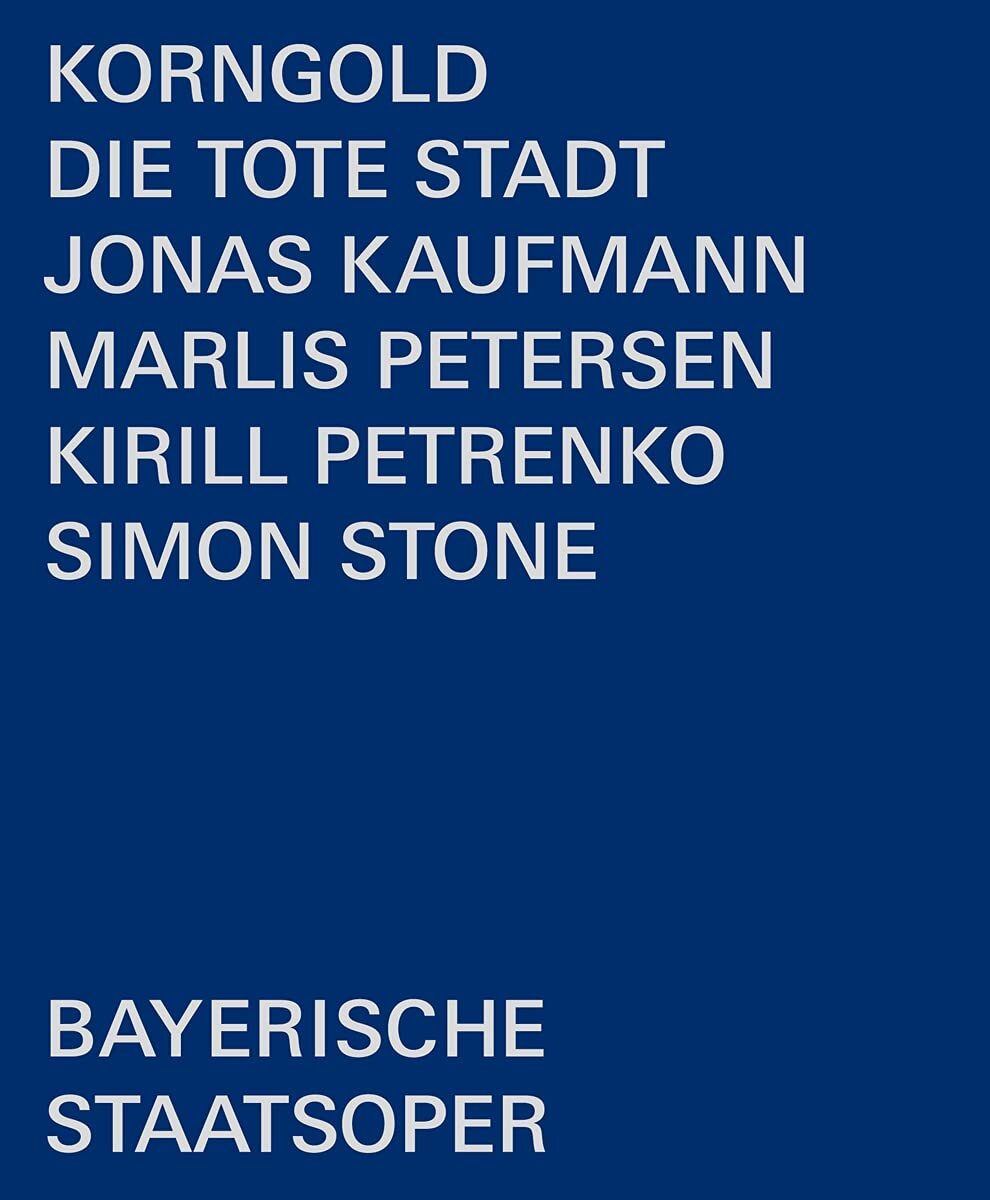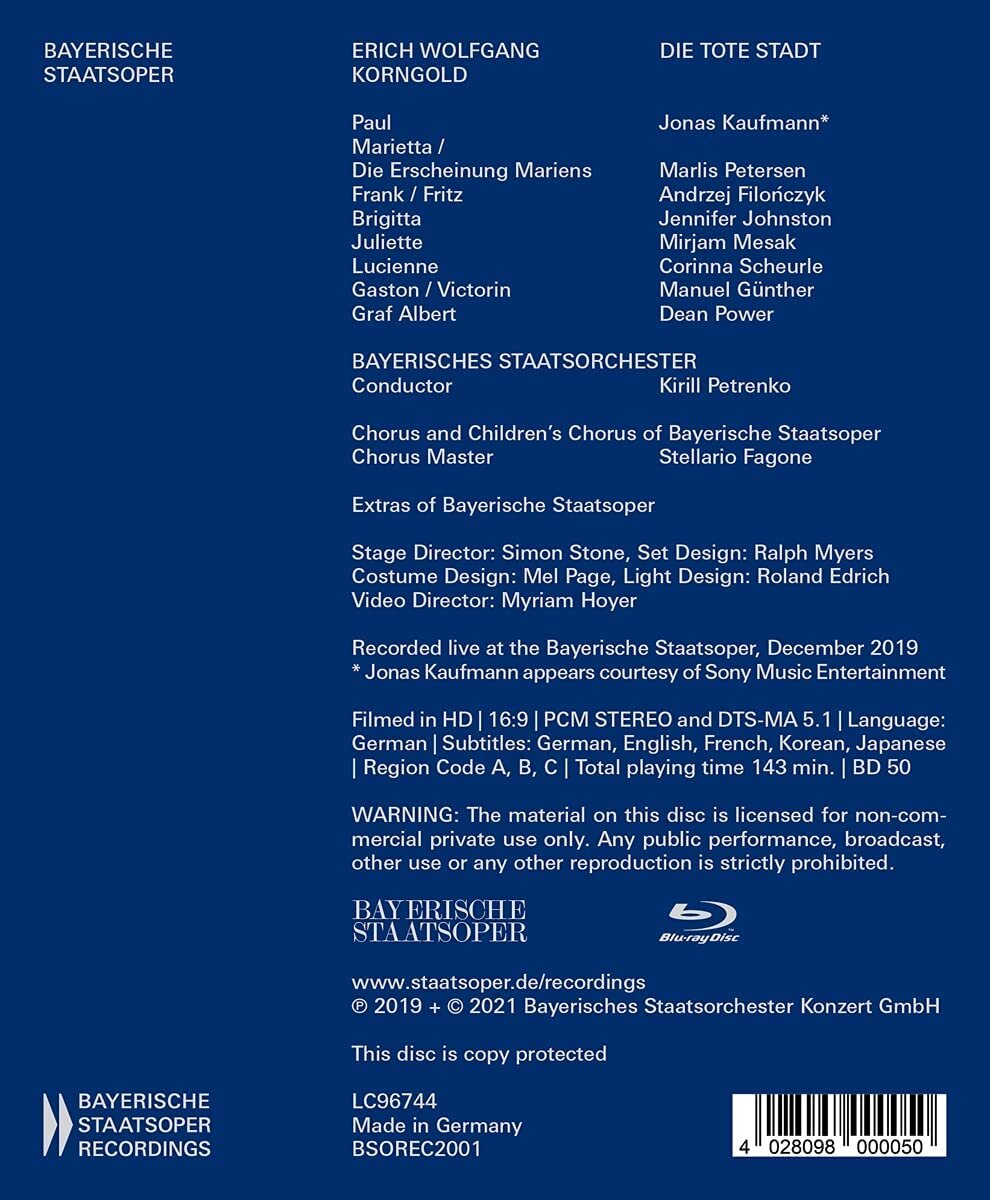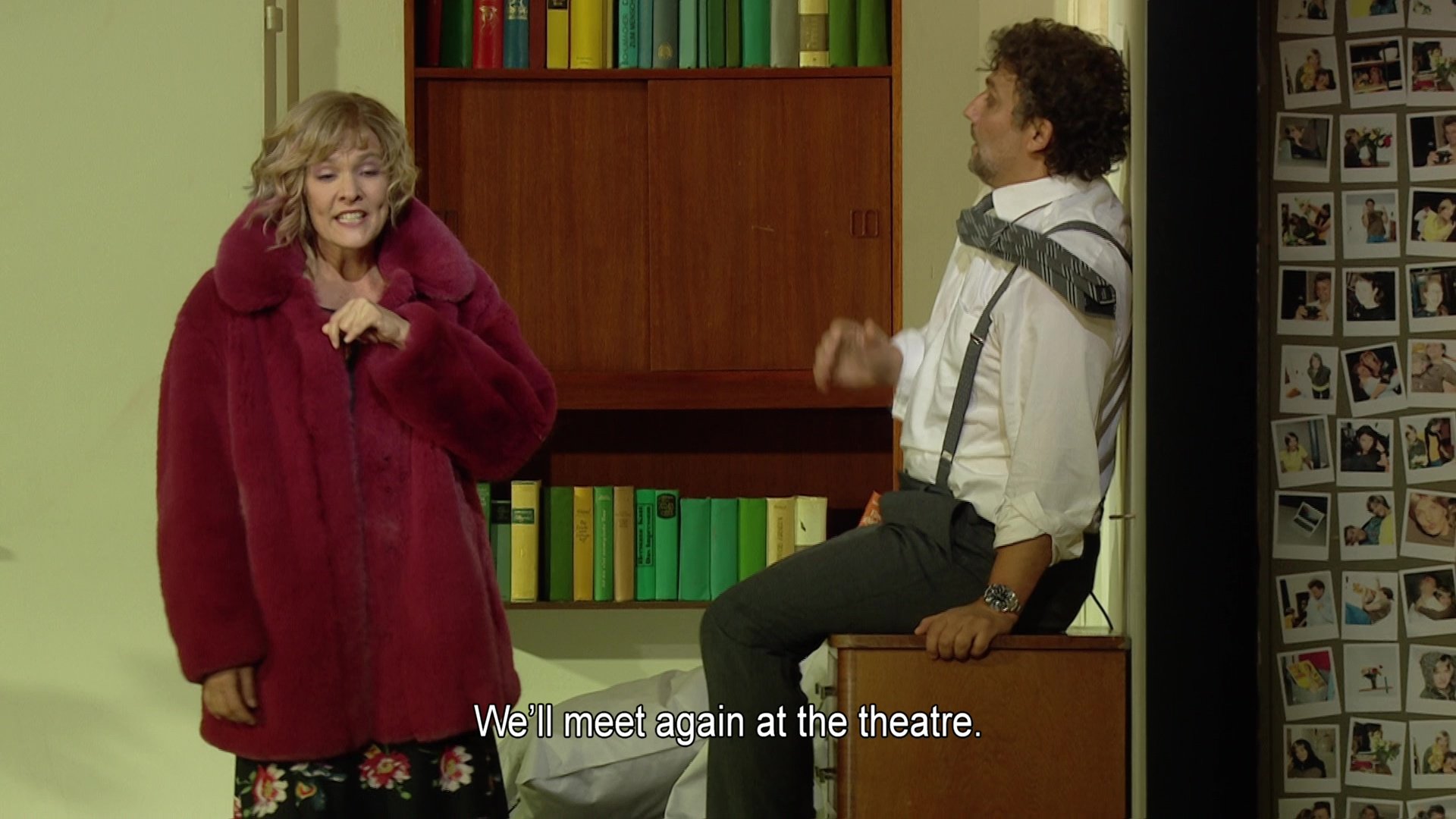

Erich Wolfgang Korngold Die tote Stadt opera to a libretto by the composer and his father, Julius Korngold, under the collective pseudonym of Paul Schott. Directed 2019 by Simon Stone at the Bayerische Staatsoper, Munich. Stars Jonas Kaufmann (Paul), Marlis Petersen (Marietta/Die Erscheinung Mariens [The Apparition of Marien]), Andrzej Filończyk (Frank/Fritz), Jennifer Johnston (Brigitta), Mirjam Mesak (Juliette), Corinna Scheurle (Lucienne), Manuel Günther (Gaston/Victorin), and Dean Power (Graf Albert). Kirill Petrenko conducts the Bayerisches Staatsorchester and the Chorus and Children’s Chorus of the Bayerische Staatsoper (Chorus Master Stellario Fagone). Sets by Ralph Myers; costumes by Mel Page; lighting by Roland Edrich. Directed for TV by Myriam Hoyer; produced by Dr. Roland Schwab and Guido Gärtner. Sung in German. Released 2020, disc has 5.1 dts-HD Master Audio sound. Grade: A
This title created more excitement and critical praise than any other in 2021. It’s hard to imagine anyone doing better by Korngold’s libretto and score. But for me, the best thing about this title is that it led to my reading of the book behind it: Bruges-la-Morte by the symbolist poet and novelist George Rodenbach. Finally, it was exciting to see our new super-nova videographer, Myriam Hoyer, at work on a recent important opera production. So in this review, I’ll tell you about the opera, the book, and finally, Hoyer’s video.
The Opera
This is a story about Paul, a man grieving too long over the death of his wife. The story comes from 1892; director Stone moves it to today. Paul (Jonas Kaufmann) is wealthy and can afford to do nothing for years but mourn. Below you see his comfortable house, which is mostly in mothballs. On the right, Paul is visiting with an old friend, Frank (Andrzej Filończyk):
Paul shows Frank a shrine Paul has created in memory of his late wife Marie. Paul’s most important relic is Marie’s hair. Paul is actually hoping for a resurrection:
But Paul’s normal mood of profound grief has recently turned into giddy excitement because he saw a woman in the street who looks like his memory of Marie—maybe there has been a resurrection! Frank is worried about Paul’s mental health:
The girl Paul met is Marietta (Marlis Petersen). Paul talked her into visiting him. She’s a dancer at the opera. She can also sing. This leads to maybe the saddest duet ever, “Glück das mir verblieb”:
The song reinforces Paul’s feeling that a miracle is taking place and an affair is starting:
The budding romance is upended by Gaston (Manuel Günther), Lucienne (Corinna Scheurle), and Juilette (Mirjam Mesak) reminding Marietta that it’s time for a rehearsal at the opera:
But before she leaves with her friends, Marietta stumbles onto Paul’s shrine. Marietta is even wearing a dress similar to one she sees in the pictures!
Paul wants Marietta to stay. But Marietta is wary. She avoids further complications by suggesting he should come to the opera to see her:
How many movies have you seen where it’s hard to tell whether actions seen on the screen are part of the “real” world of the movie or only the thoughts or a nightmare of a character? It’s a common device in movies, but how do you do this on an opera stage? When I first saw director Stone’s show, I failed to realize what had happened and got confused. I’ll give you a clue. Stone has all the lights in his set flicker dramatically at the beginning and the end of the dream. (In between, there’s another flicker I never figured out.) In the next image below we are in the dream. The apparition of Marie is upset that Paul has an interest in Marietta.
Marlis Peterson wanted this part! She had to shave her head so she could swap wigs with a skullcap! Stone needs her do this so the same soprano will look like two different women to the audience. Is this SOP for sopranos who take this role? I don’t know. But I do know this: at first I thought Marie and Marietta were different women! I had to consult the keepcase booklet to clear up my confusion:
Thus begins a titanic battle between Paul’s fetish for mourning Marie and his attraction to Mariette. Marie wins the first skirmish in one of Miriam Hoyer’s many fine close-ups:
Below left Paul has a falling out with Frank. Below right Marietta’s friends throw a wild party at Marietta’s apartment. We met 3 of the party guests before at Paul’s window (Manuel Günther is now called Victorin). The man in the tux is Graf Albert (Dean Power). Behind the pole is a character called Fritz made up like the traditional sad clown Pierrot. He is none other than Andrzej Filończyk again, who has also made a quick change of costume!
Below my favorite Hoyer close-up:
Below left, sanctimonious Paul blames Marietta for his weakness. Below right Marietta ably defends herself.
Marietta with her living flesh seems to have the upper hand. But later she bemoans that the only man she ever loved seems intent on destroying her:
Suddenly we get some obscure scenes with people from the town participating in a religious celebration. If you know the story from the Rodenbach book or having studied up, you would be prepared for this. Otherwise, this will be bewildering:
At the climax of the show, Marie and Marietta engage head on, woman-to-woman:
And the living woman loses as Paul strangles her. The weapon? The sacred hair he preserved from Marie:
As soon as Marietta dies, the lights start flickering again. The dream is over. Suddenly you see Marietta leaving Paul’s residence. Nothing has happened. It was all a dream.
And now we have a happy ending! Paul is shook up. He comes to his senses after all those years of pointless mourning! He starts burning the relics. He will take up Frank’s suggestion that it’s time to leave Bruges. He asks his dead wife to be patient. He now understands there will be no resurrection for her in this world. Paul is cured of his melancholy:
Print critics who saw this live in 2019 were ecstatic. And Clive Paget gushed a torrent of praise for the Blu-ray in his “Critic’s Choice” review at pages 63-64 of the November 2021 Opera News. Paget reports that Kaufmann is “adept” and Petersen is “an ideal Marietta.” He concludes this is the best video yet of Die Tote Stadt. In the 2021 “Awards Issue” of Gramophone, Richard Bratby is also full of praise. In November 2021, Presto Music announced their list of the 100 best classical recordings from 2021. This Tote Stadt was the only Blu-ray on the list.
I agree that the singers cast are good, especially the indestructible Marlis Petersen. But after seeing this several times, I was not convinced. Time to dig a bit.
The Book
Bruges-la-Morte was published in 1892. Rodenbach was Flemish, but he worked as a lawyer in Paris and wrote in French. Next below is a portrait of George by the symbolist artist Lucien-Levy -Dhurmer. And below that is an image of Georges’ grave in Paris.
H’m, what’s the deal with our symbolist George? Well, we have encountered symbolist literature before. As described by Jean Moréas in 1886, in symbolism things that happen in the world ". . . will not be described for their own sake . . . they are perceptible surfaces created to represent their esoteric affinities with the primordial Ideals." George was a contemporary of another symbolist Flemish writer named Maeterlinck, who also lived in Paris and published in French the play Pelléas et Mélisanne in 1892 (the same year Rodenbach published Bruges-la-Morte). Debussy turned the play into the famous Pelléas y Mélisande opera.
Mike Mitchell made a good English translation of Bruges-la-Morte (Brugges the Dead). It’s an easy but absorbing read in prose poetry that is surprisingly modern in vocabulary and tone. Below is the cover to the beautiful Dedalus edition. Bruges-la-Morte is believed to be the first work of fiction to be illustrated with photographs of the places described in the book. The photos in the Dedalus edition are different from the original, but are effective.
The book has only 3 human characters: the grieving widower, the new woman, and the housekeeper. An inanimate character is the old center city of Bruges, which in 1892 was mourned as a dying town. (It’s now considered a quiet but edifying tourist destination.) In 157 pages of exquisite symbolist imagery, the identity of the grieving husband merges into the morbidity of the ancient town. The dead wife is never named. The word resurrection is not in the book. The new woman only resembles the deceased. Writing before the concept of the unconscious mind was popularized by Freud, Rodenbach frames the widower’s problem as a struggle between man’s love of habit and man’s craving for novelty. When the new woman ultimately disappoints the widower, the result is more death and total ruin. Bruges-la-Morte is called a profound meditation on grief. Perhaps it also foreshadows the ruin that would befall all Europe in the two great wars soon to come.
What is an opera? I define it as a story with music with at least 3 of the following 4 elements: love, sex, power, and violence. Bruges-la-Morte has some elements of love and violence, but no sex or power. I image that the symbolist composer Debussy knew Rodenbach’s novel and thought it too ethereal to be staged as an opera. Instead, Debussy went for Pelléas et Mélisande, a story with many characters and events and plenty of love, sex, power, and violence.
So how did the Korngold father and son team make an opera from Bruges-la-Morte in 1920, two years after the end of World War I? Well, they turned it into a story about death and resurrection. They added interesting characters like Frank and Marietta’s theater friends plus a happy ending. It’s not a story about love, sex, power, and violence. It a story about a widower stuck in a rut who is cured by a neurotic dream. Is this the stuff of high art? Or is it more the plot for a movie, or in today’s terms, a cool Netflix original?
Korngold’s music is grand as played by the vast orchestra pictured below directed by one of the most successful musicians working today. Still, I suspect it’s no accident Korngold wound up mostly writing movie music for Hollywood. Maybe Korngold was born with the movie-music gene:
The rest of the world views Die Tote Stadt as a serious opera, and probably the rest of the world is right. But I see Die Tote Stadt as high-end, entertaining musical theater. Or maybe as a movie produced in an opera house . . . which leads to our next topic.
Miriam Hoyer
We have long accused the industry of publishing fine-arts material for DVD viewers and not for those with high-definition TVs. Typically, the same video file that’s optimized for DVD is republished in Blu-ray as an additional profit center. True, the images and sound in the Blu-ray are better than in DVD. But the video content suffers from DVDitis: too many clips too close-up where the poor DVD image resolution is not so noticeable to the viewer. We did have two video heroes who would consistently give us longer-range views and longer-duration clips that would take full advantage of our HD TVs: Vincent Batallion (ballet titles) and François Roussillon (operas). (The situation with symphonic music recordings was an almost total disaster from 2008 to 2022 except for a dozen or so demo titles from the Japanese National Broadcasting Co.)
But now we have a new hero, or rather heroine, in Miriam Hoyer. Between 2011 and 2016 Hoyer got 5 credits on this website as Director for TV for relatively modest productions. Since then she moved into the Blu-ray big time with 3 fine videos for John Neumeier, an Elektra at the Salzburg Festival, a show for the Wiener Staatsoperballet, and now Die Tote Stadt at the Bavarian State Opera!
I looked closely at Hoyer’s work on Neumeier’s ballet Ghost Light title and found the file free of DVDitis. And I have always relaxed the video standards for movie-style work. In movies, almost anything goes if it’s done well. Now look again at the screenshots above from Hoyer. She provides a huge range of images from full-screen views to extreme close-ups, all with admirable attention to the flow of the drama. I don’t think Die Tote Stadt is a great opera. But it’s performed and recorded here with all the respect due to great opera. So this could easily be the definitive video of Die Tote Stadt for a long time. Sum up: watch and enjoy this Die Tote Stadt. Then try the book. Then thank Korngold for bringing the book to your attention. Grade: A
Here’s the official trailer. The video is much better than this suggests:
OR































